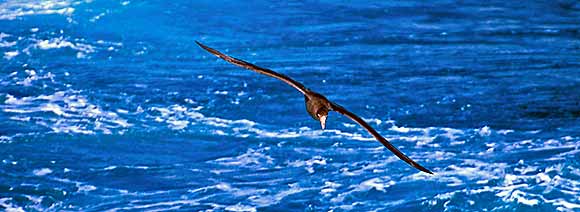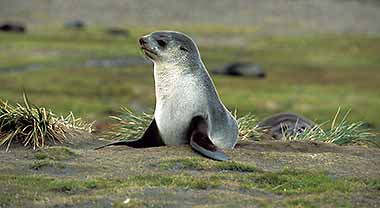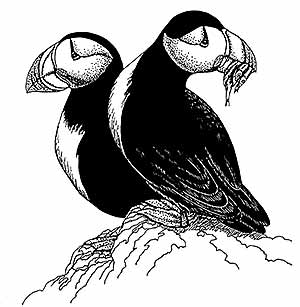| Cloud Ridge Naturalists 2 0 0 5 | ||||
 |
||||
| Sooty shearwater,photo Audrey Benedict | ||||
| Bering Sea Expedition: Russia's Kamchatka Peninsula, the Aleutian Archipelago, and the Pribilofs |
||||
| C O N T E N T S | ||||
|
HOME PAGE / INTRODUCTION 2005 OF TIGER WALLS & CANYON WRENS: A Naturalist's Journey on the Yampa & Green Rivers IMAGES OF WILDERNESS: Southeast Alaska's Outer Coast aboard the MV Snow Goose RAFTING THE HULAHULA: A River Journey through the Arctic National Wildlife Refuge VOYAGE TO THE LAND OF THE ICE BEAR: A Circumnavigation of Svalbard (Spitsbergen) BERING SEA EXPEDITION: Russia's Kamchatka Peninsula, the Aleutian Archipelago, and the Pribilofs |
July 31-August 15, 2005 Tour Leaders: Audrey Benedict, Ron Russo and the Expedition and Naturalist Staff of the Clipper Odyssey This unique, expeditionary voyage aboard the MS Clipper Odyssey will take us across the Bering Sea – deep into the heart of the Pacific Ocean’s "Ring of Fire." As we journey from the majestic snow-capped volcanoes of the Kamchatka Peninsula to the remote, jewel-like islands of the Bering Sea – the Aleutian archipelago, the Pribilofs, St. Mathew and Hall islands, and the northernmost Alaskan outposts, Gambell and St. Lawrence – we will witness one of the most extravagant displays of life on earth. We’ll take a chartered flight from Anchorage to the Kamchatka Peninsula, joining the Clipper Odyssey at the Russian fishing port of Petropavlovsk, one of the oldest settlements in the Russian Far East. The Kamchatka Peninsula is known as the "Land of Smoking Volcanoes," and with 29 of its 300 volcanoes still active it is easily the most spectacular volcanic landscape on earth. After we board our ship, a flight by helicopter will take us past the breathtaking Karymsky Volcano to a landing spot in the Valley of the Geysers, a volcanic moonscape where plumes of sizzling water and gaseous plumes billow toward the sky. On foot and by Zodiac, we’ll explore the pristine Zhupanova River a wilderness area renowned for the possibility of spotting one of the enormous Kamchatka brown bears as it feasts on spawning salmon and for nesting populations of Steller's sea-eagle. With its nearly 10-foot wingspan, this fish-eating eagle ranks among the largest in the world and is one of the heaviest of all flying birds. After cruising along the Kamchatka Peninsula, the Clipper Odyssey will head eastward to visit Bering Island, the final resting place of Commander Vitus Bering, and then across the open ocean for two days to reach Attu, the westernmost island in the Aleutian chain.
Juvenile fur seal, photo Audrey Benedict During our open ocean passages, pelagic birds such as albatrosses, fulmars, petrels, storm-petrels, and shearwaters will be frequent visitors to the wake of our ship, swooping in a graceful aerial ballet over the jade-green sea as they search for food. Daily sightings of whales and other marine mammals may be common – the exciting possibilities include orca, humpback, gray, minke and sperm whales, Dall’s porpoise, and Pacific white-lined dolphin.
Steller's sea lion, photo Audrey Benedict Stirred by tides, nutrient-rich upwellings, and notorious winter gales, the incredible biological productivity of the Bering Sea – a rich bouillabaisse of plankton, krill, shellfish, squid, and myriad schools of herring and other fish – supports immense populations of seabirds and marine mammals. Sheer sea cliffs interspersed with headlands of emerald-green tundra provide critical breeding habitat for several million seabirds – puffins, murres, auklets, dovekies, fulmars, kittiwakes, gulls, and cormorants. Whichever islands we visit – Bering, the chain of islands that make up the Aleutian archipelago, the Pribilofs, St. Paul, Hall, St. Mathew, or St. Lawrence – the splendid cacophony produced by some of the world’s largest seabird colonies is matched in intensity only by the mighty bellowing of staggering numbers of northern fur seals and Steller sea lions at their haul-outs and rookeries. On the magnificent Pribilofs, two pinpoints of land measuring all of 80 square miles, an estimated 750,000 northern fur seals and 3 million seabirds provide one of the most amazing wildlife spectacles in the world. While at sea, we’ll enjoy lectures on natural history, the history and culture of the Russian Far East, the voyages of Vitus Bering, the lifeways of the Aleuts and the Bering Sea Eskimo, as well as the sea-sized conservation challenges impacting this fascinating region. To be a part of all this – the extraordinary wilderness world of the Bering Sea, its exquisitely beautiful islands, and biological wealth – is a rare privilege. To be able make a voyage of this type aboard a wonderfully comfortable, fin-stabilized ship such as the Clipper Odyssey is remarkable indeed!
Group Limit: 18 Price: Category 1: $6,602 (A-deck w/ portholes) Price includes: Not Included: Important Message Concerning Expedition Cruises |
|||
| Contact: | Cloud Ridge Naturalists 8297 Overland Road Ward Colorado 80481 email > cloudridgeadb@earthlink.net |
|||


